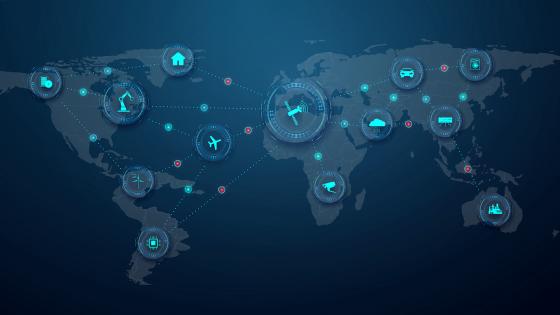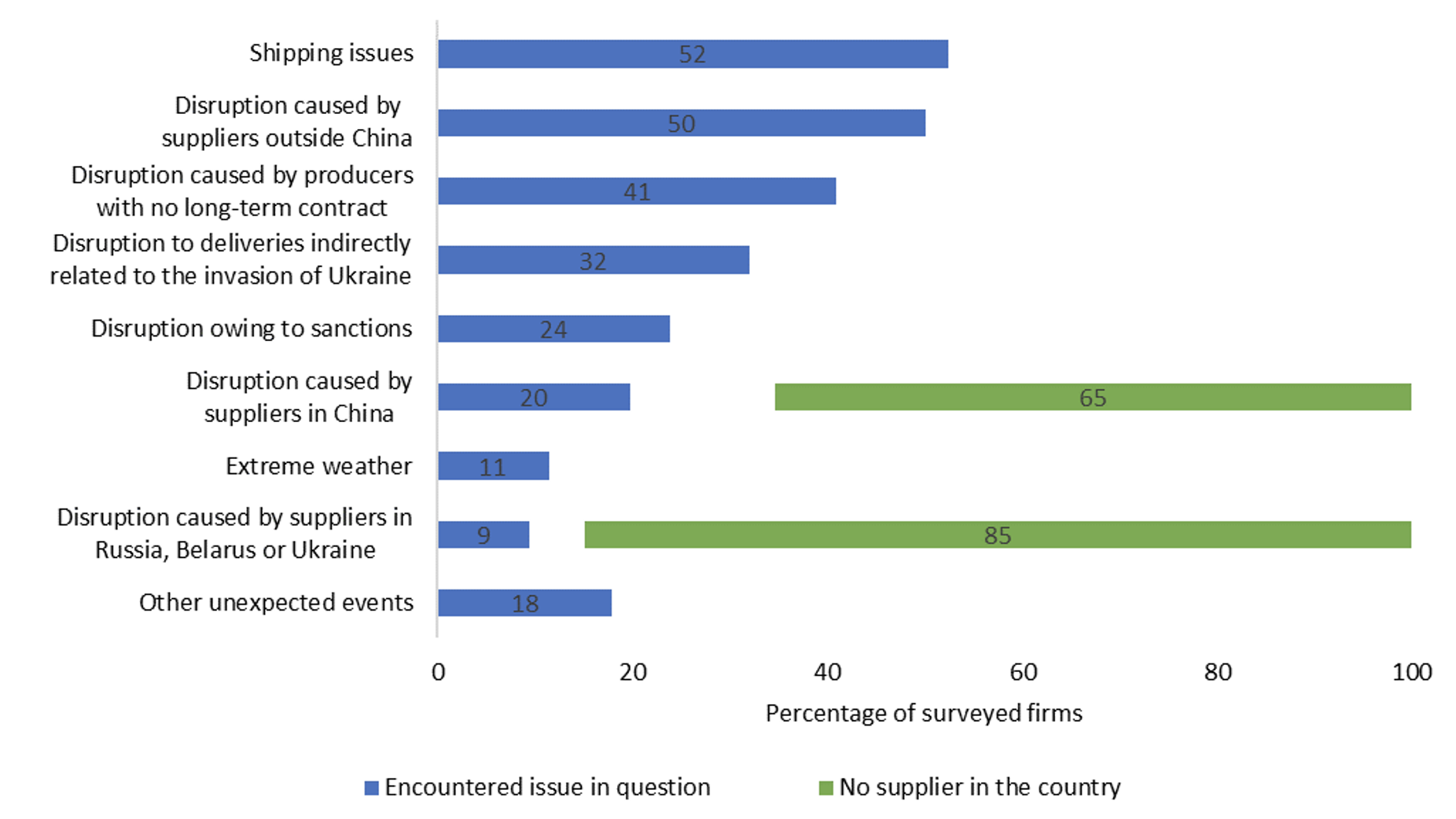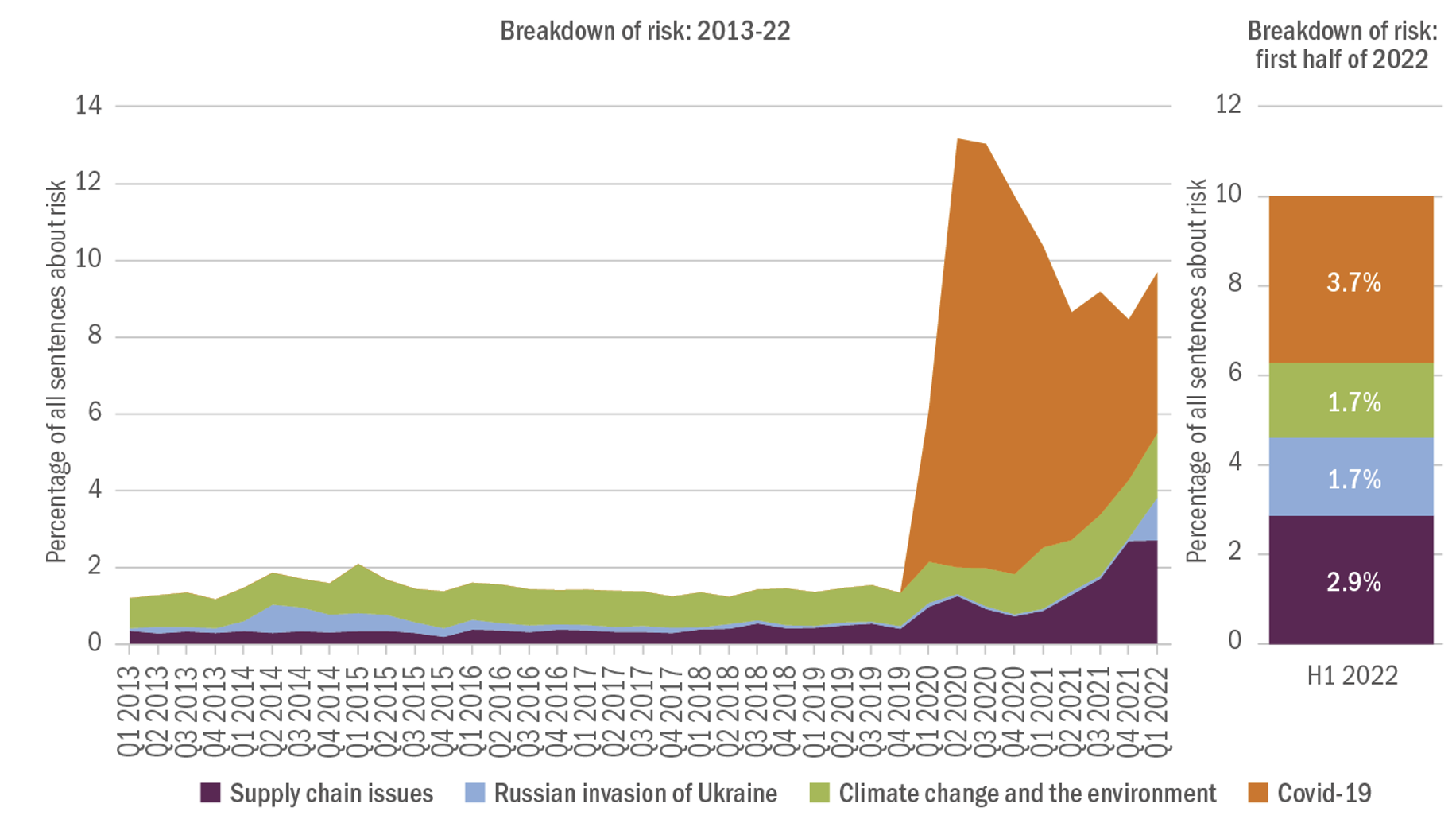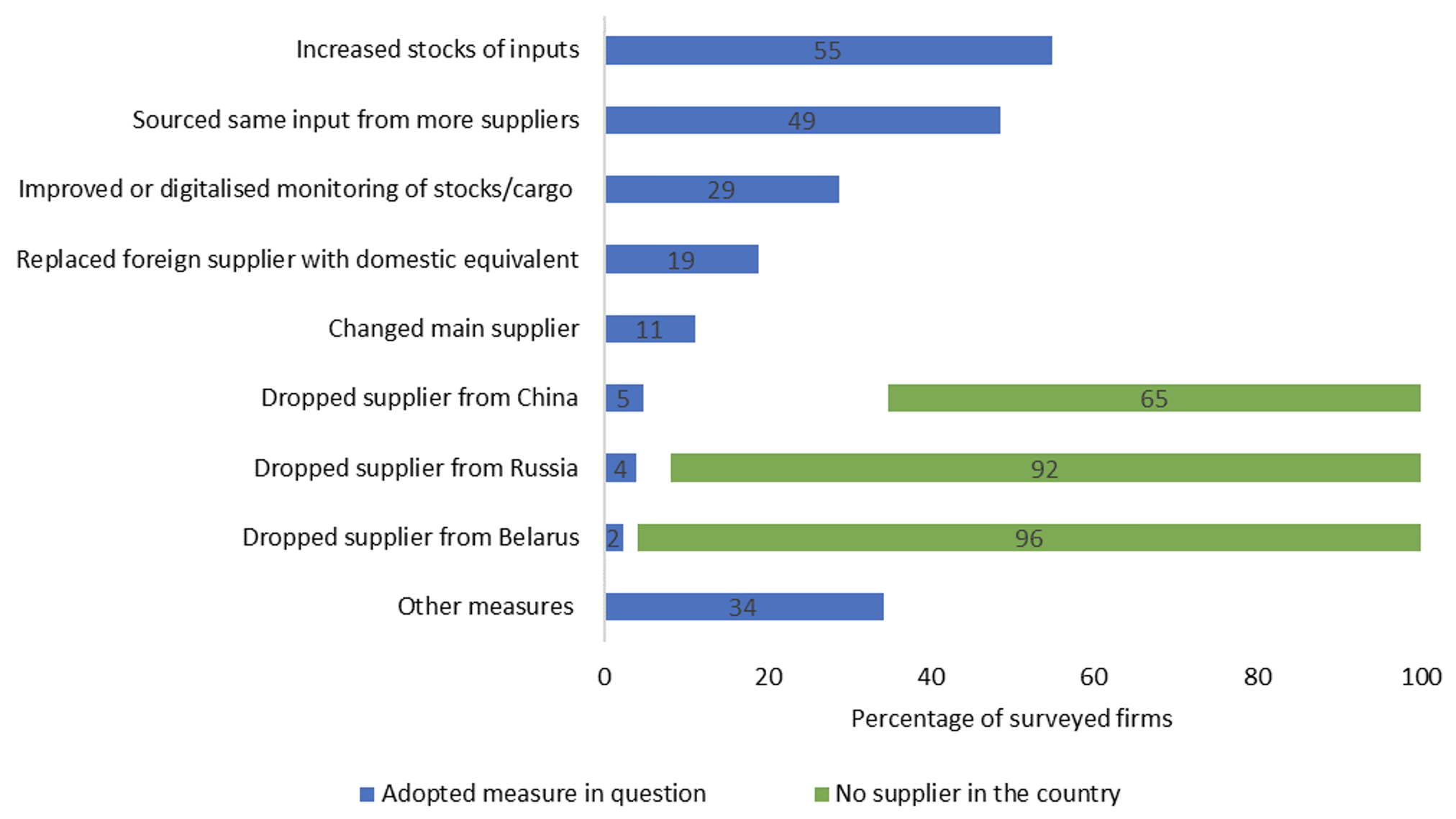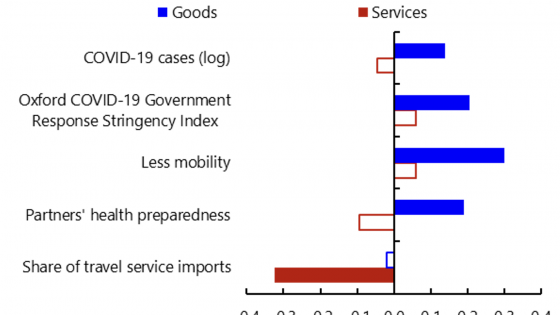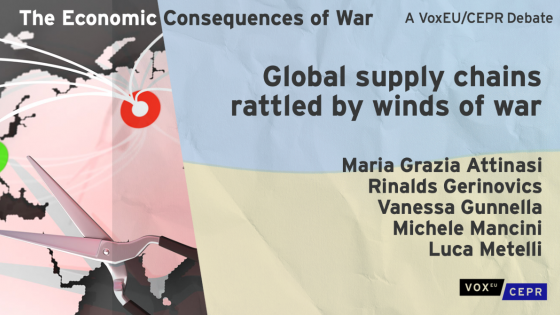The last couple of years have seen many disruptions to ‘business as usual’ and ‘trade as usual’. Recent large-scale supply-side disruptions include the Covid-19 pandemic, the port congestion during the post-pandemic recovery, the blockage of the Suez Canal, and the Russian invasion of Ukraine. Trade disruptions appear to have increased in frequency and are likely to destabilise global supply chains going forward, too. At the same time, international political cooperation has begun to falter, and many people have become disenchanted with free trade.
The Russian invasion of Ukraine, in particular, has been a trigger for global supply chain reshuffling – defined here as firms’ diversification of their supplier base in order to achieve greater resilience (Baldwin and Freeman 2022). This is not because Belarus, Russia, and Ukraine were highly integrated in global supply chains themselves (Attinasi et al. 2022). Instead, the war has cemented the belief that supply-chain disruptions are not going away soon as it has created prospects of further geopolitical (and thus trade) tensions. In Chapter 3 of Business Unusual, the EBRD Transition Report 2022-23, we document the extent of disruptions that firms have faced and the actions they took to adapt and to boost their resilience (EBRD 2022: Chapter 3).
Trade disruptions were not just caused by China
To better understand the challenges firms have faced on account of the Covid-19 pandemic and Russia’s invasion of Ukraine, the European Bank for Reconstruction and Development (EBRD) conducted a short telephone survey between May and July 2022, talking to 815 firms that are both direct exporters and importers in 15 countries: Bosnia and Herzegovina, Bulgaria, Croatia, the Czech Republic, Estonia, Hungary, Lithuania, Morocco, Poland, Romania, Serbia, the Slovak Republic, Slovenia, Tunisia, and Turkey.
More than three-quarters of these firms had experienced at least one disruption to deliveries of inputs since the start of the pandemic. Importantly, these disruptions were not driven just by China; a significant proportion of firms had experienced disruption to deliveries caused by other factors. Overall, more than half of firms reported that they had encountered shipping issues, half had experienced disruption to deliveries from suppliers outside China, and 41% reported disruption to deliveries from wholesalers or producers with whom they did not have long-term contracts (Figure 1). Only a fifth of firms had experienced disruption to deliveries from suppliers in China, while almost a quarter of firms reported disruption caused by Russia’s invasion of Ukraine and the resulting international sanctions.
Figure 1 More than half of all surveyed firms in the EBRD regions had encountered disruption to deliveries owing to shipping issues
Source: EBRD Transition Report 2022-23.
Note: Based on the responses of 815 firms across 15 economies in the EBRD regions that both export and import.
Uncertainty about supply chains affects firm performance
Even before the pandemic, concerns about supply chains were on the rise. When international trade wars intensified in 2018, many executives talked about reshuffling their supply chains. However, analysing earnings calls transcripts, using the NL Analytics platform, we find that the current squeeze on supply chains has executives more concerned about the sourcing of inputs than ever before (Javorcik et al. 2022).
The analysis, using the method pioneered by Hassan et al. (2019), identifies sentences related to supply chain topics by checking for relevant keywords, chosen with the help of NL Analytics’ keyword tool, and tracks whether they are used in combination with the terms ‘risk’, ‘risky’, ‘uncertainty’, ‘uncertain’, or any of their synonyms. A similar approach is used to identify risks related to the pandemic, climate change, and the war.
The share of sentences on risk containing supply chain-related keywords was relatively stable from 2013 to 2019, but then increased sharply between 2020 and 2022 (Figure 2). At the peak of the pandemic in the second quarter of 2020, 12% of all sentences containing a risk-related keyword concerned Covid-19. By the first half of 2022, there were almost as many risk-related sentences about supply chains (2.9%) as there were about Covid-19 (3.7%). Based on this metric, supply chains were a bigger concern for global firms and investors in the first half of 2022 than climate change and the war in Ukraine (which were cited in 1.7% of risk-related sentences each). In a subsample of firms headquartered in an EU member state or an EBRD country of operation,
the Russian invasion of Ukraine played a larger role, featuring in 4.5% of all risk-related sentences in the first half of 2022.
Figure 2 Supply chain risks are among the top causes of concern for global firms and investors
Source: EBRD Transition Report 2022-23.
Note: Data are as of 13 July 2022. This chart shows the percentages of risk-related sentences that contain keywords relating to specific topics. Risk-related sentences are sentences that contain the words ‘risk’, ‘risky’, ‘uncertainty’, or ‘uncertain’ (or any of their single-word synonyms). Supply chain keywords (‘global chain’, ‘logistic chain’, ‘logistical chain’, ‘sub-supplier’, ‘supplier(s)’, ‘supply chain’, ‘supply logistic’, ‘supply network’, ‘supply technologies’, and ‘value chain’) were identified with the NL Analytics keyword tool. Covid-19 keywords (‘corona virus’, ‘coronavirus’, ‘covid’, ‘covid19’, ‘ncov’, and ‘sarscov’) were taken from Hassan et al. (2020). Keywords relating to Russia and Ukraine were taken from Hassan et al. (2021) and keywords relating to the invasion of Ukraine from NL Analytics’ keyword tool. Keywords relating to climate change and the environment were taken from Sautner et al. (2021) and NL Analytics’ keyword tool.
Uncertainty about supply chains may affect firm performance. To analyse this link, we combined the average sentiment and perceived risk for each year and industry (at the three-digit level of the SIC classification) with data on more than 48,000 large manufacturing firms for the period 2013-21. We find that supply chain disruptions have already had a material impact on firm performance. A one standard deviation increase in the supply chain risk measure is associated with a 0.4% drop in investment and a 0.14 percentage point lower profit margin. These results suggest that insuring against supply chain risks may be worthwhile in terms of firms’ bottom lines, despite the cost of implementing such measures.
Firms are adapting by reshuffling their supply chains
Indeed, the EBRD survey shows that more than three-quarters of all firms participating in global supply chains have implemented at least one measure to make their supply chains more resilient. The most common measure was an increase in stocks of inputs (moving from just-in-time to just-in-case), followed by diversification of the supplier base (global supply chain reshuffling) (Figure 3). Most new suppliers are from abroad, with only around a fifth of firms switching from an international supplier to a domestic one.
Figure 3 More than three-quarters of surveyed firms took steps to increase supply-chain resilience
Source: EBRD Transition Report 2022-23.
Note: Based on the responses of 815 firms across 15 economies in the EBRD regions that both export and import.
Despite pandemic-related disruption, few firms have dropped Chinese suppliers. Instead, firms with suppliers in China were more likely to invest in digital technology, increase stocks of inputs, or started sourcing the same input from a larger number of suppliers. In other words, they were more likely to reshuffle their global supply chains.
Similar trends were observed in Germany when equivalent questions were put to 3,000 manufacturers as part of the ifo Business Survey in July 2022 (Aksoy et al. 2022). More than 87% of those firms had taken steps to increase the resilience of their supply chains. Like firms in the EBRD regions, German firms mainly opted for measures that were quick to implement: increasing stocks of inputs (adopted by 68% of firms) and diversifying their supplier base (65%). More than half improved their monitoring of supply chains, and over a third switched between existing supply relationships, while 13% sought to produce inputs in house, having previously outsourced them to independent suppliers, thereby increasing the vertical integration of production through insourcing. These trends are likely to continue. Within the next 12 months, almost half of German manufacturing firms plan to find additional suppliers and more than a third plan to increase their stocks of inputs (Aksoy et al. 2022). One in three firms intend further reallocation between existing suppliers.
Concluding remarks
Trade flows data suggest that the supply-chain disruptions of early 2020 were of a temporary nature (Lan et al. 2022), and most firms did not take steps to improve the resilience of their supply chains. However, they started doing so in response to the Russian invasion of Ukraine. Rather than sourcing more components domestically (reshoring) or from friendly countries (friendshoring), firms have begun to source more inputs from suppliers in different countries, as well as stockpiling inputs.
References
Aksoy, C G, A Baur, L Flach and B Javorcik (2022), “Reacting to supply chain disruptions: Evidence from German firms”, EconPol Policy Brief 45.
Attinasi, M G, R Gerinovics, V Gunella, M Mancini and L Metelli (2022), “Global supply chains rattled by winds of war”, VoxEU.org, 8 June.
Baldwin, R and R Freeman (2022), “Global supply chain risk and resilience”, VoxEU.org, 6 April.
EBRD (2022), “Global supply chains in turbulence”, Chapter 3 in Business Unusual, EBRD Transition Report 2022-23.
Flach, L, J Gröschl, M Steininger, F Teti and A Baur (2022), “Internationale Wertschöpfungsketten – Reformbedarf und Möglichkeiten”, Ifo Forschungsberichte 133.
Hassan, T A, S Hollander, L Van Lent and A Tahoun (2019), “Firm-level political risk: Measurement and effects”, Quarterly Journal of Economics 134(4): 2135-2202.
Hassan, T A, S Hollander, L Van Lent, M Schwedeler and A Tahoun (2020), “Firm-level exposure to epidemic diseases: COVID-19, SARS, and H1N1”, NBER Working Paper No. 26971.
Hassan, T A, J Schreger, M Schwedeler and A Tahoun (2021), “Sources and transmission of country risk”, NBER Working Paper No. 29526.
Javorcik, B, L Kitzmüller and H Schweiger (2022), “The Big Squeeze: Evidence on Global Supply Chain Disruptions from Earnings Calls Text Data”, EBRD working paper, forthcoming.
Lan, T, D Malacrino, A Mohommad, A Presbitero and G Shar (2022), “Shocks, international trade, and diversification: Lessons from the pandemic”, VoxEU.org, 11 May.
Sautner, Z, L van Lent, G Vilkov and R Zhang (2021), “Firm-level Climate Change Exposure”, ecgi Finance Working Paper, June.
